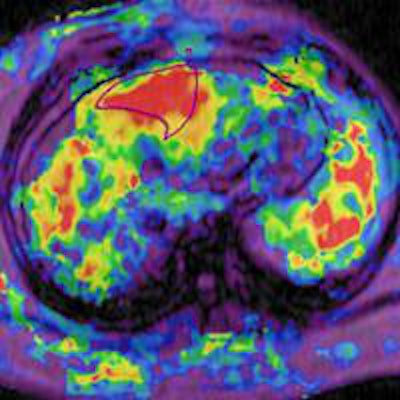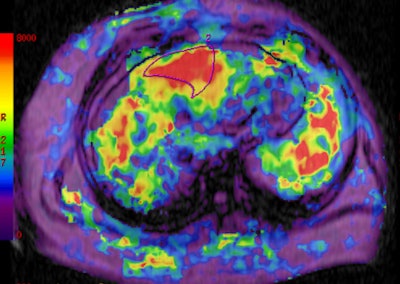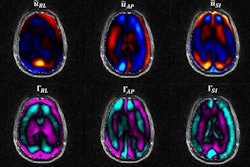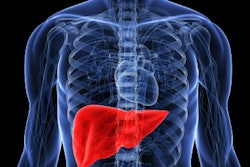
MR elastography (MRE) can help physicians accurately detect fibrosis in obese children with chronic liver disease, according to a study published online September 23 in the Journal of Pediatrics.
MRE could be particularly beneficial in cases of nonalcoholic fatty liver disease (NAFLD), which is increasingly common in children and teens and affects approximately 13% of adolescents. NAFLD can lead to progressive liver disease and liver failure, and many pediatric patients with the condition are severely obese.
The study was led by Dr. Stavra Xanthakos, co-director of the Steatohepatitis Center at Cincinnati Children's Hospital Medical Center.
Need for noninvasiveness
"The management of chronic liver diseases in children is impeded by lack of validated noninvasive biomarkers of histologic severity, necessitating invasive and costly liver biopsies," the authors wrote. "An accurate noninvasive method to detect significant liver fibrosis would reduce dependence on liver biopsies, facilitate the conduct of pediatric randomized clinical trials, and improve the ability to track clinical outcomes" (J Pediatr, September 23, 2013).
Previous research has shown MRE to be effective in detecting significant hepatic fibrosis in adult patients, but its effectiveness in children is unknown, the group explained.
MRE has been used to determine fibrosis along with two ultrasound-based methods: transient elastography and acoustic radiation force imaging (ARFI) elastography. However, while transient elastography and ARFI elastography have proved useful in children with liver disease, both techniques are less effective for obese patients.
The current study included 35 subjects between the ages and 4 and 20 years who were evaluated with MRE and liver biopsy as part of their clinical evaluation for chronic liver disease. The participants (18 males and 17 females) were tested at Cincinnati Children's Hospital Medical Center between August 2011 and December 2012. Median body mass index of the group was 33.9 kg/m2.
MRE was performed on a 1.5-tesla MRI scanner (Signa Excite HDx, GE Healthcare), with readers rating the extent of fibrosis from stage 0, meaning no evidence of the condition, to stage 4, indicating the presence of cirrhosis.
Xanthakos and colleagues found that 27 of the subjects had NAFLD, and of the 27, 22 had borderline or definite nonalcoholic steatohepatitis. On histologic staging, 27 subjects had minimal or no fibrosis: 11 had stage 1 fibrosis and the other 16 were stage 0 with no fibrosis. Eight subjects had significant fibrosis, with four at stage 2, three at stage 3, and one at stage 4.
The imaging results showed that liver stiffness increased as the stage of fibrosis became more severe, the researchers found. With a cutoff of 2.71 kPa, sensitivity was 88% and specificity was 85% for detecting significant fibrosis, with an area under the receiver operator characteristics curve of 0.92 (95% confidence interval: 0.79-1.00, p = 0.02).
 A 16-year-old girl with a history of NAFLD underwent liver MRE, which demonstrated liver stiffness consistent with severe fibrosis. The results were confirmed histopathologically on biopsy. Image courtesy of Dr. Stavra Xanthakos.
A 16-year-old girl with a history of NAFLD underwent liver MRE, which demonstrated liver stiffness consistent with severe fibrosis. The results were confirmed histopathologically on biopsy. Image courtesy of Dr. Stavra Xanthakos."Our data illustrate that MRE holds great promise to noninvasively detect fibrosis severity in pediatric liver disease, which could reduce dependence on liver biopsies, which can be misclassified due to sampling error, insufficient liver biopsy size, or fragmentation," Xanthakos and colleagues wrote.
The authors noted that the small sample size was a limitation to the pilot study, adding that larger prospective studies investigating children with chronic liver disease should be performed to validate MRE's efficacy.
"Because many pediatric patients in the U.S. with NAFLD are severely obese, MRE is likely to be superior to ultrasound-based elastography in this population, as ultrasound-based methods are less reliable in severely obese patients," Xanthakos said in a statement.
If the findings are validated in larger studies, MRE could reduce dependence on costly and invasive liver biopsies to detect fibrosis.



















